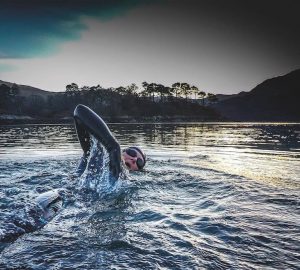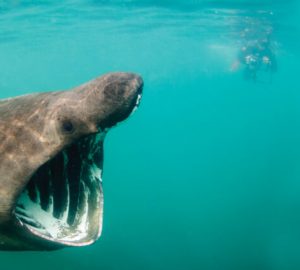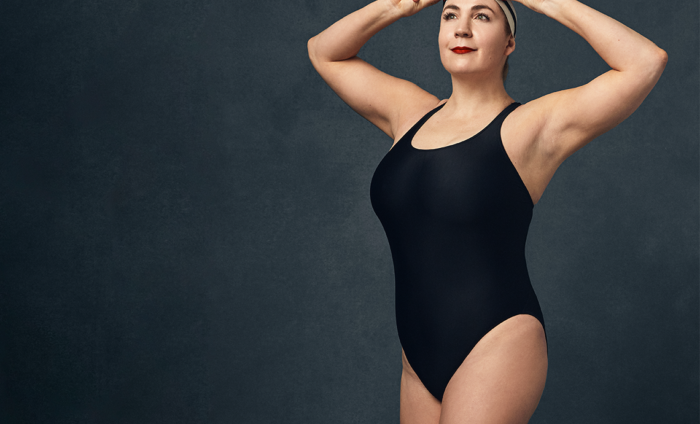
Jaimie Monahan: Queen of Manhattan
Jaimie Monahan, record-breaking marathon swimmer and Queen of the Ice, talks to Luke Chamberlain about her love affair with New York, her place in marathon swimming history and her recent quadruple Manhattan swim
“I am always impressed by people who have picked up new talents or quarantine skills during lockdown,” says Jaimie Monahan. I’ve been on the phone with the record-breaking marathon swimmer and Queen of the Ice for roughly ten minutes and already we’ve discussed new-found lockdown skills, the romance of New York City and a certain well-known pop star. “Since you referenced my fave, Taylor Swift, she had some extra time over quarantine and dropped a whole album with 24 hours-notice. I definitely admire that. All I achieved was eating probably more pasta in the first few months of 2020 than I had in the whole decade before.”
Monahan is decidedly modest – a personality trait I notice more the longer we talk. She points out a number of times that she’s not a professional swimmer – which is true. Aside from swimming, she’s a normal person working a demanding job in New York who has been affected by the pandemic just the same as anyone else.
Although if you’re any follower of marathon swimming, you will be aware that there is nothing ordinary about her achievements in the sport. In what is now a long list of accomplishments, Monahan most notably holds the world record for the fastest double circumnavigation of Manhattan, has completed the Triple Crown of Open Water Swimming, last year completed six marathon swims on six continents in 16 days, and is an inductee in both the International Marathon Swimming and Ice Swimming Hall of Fame. What’s more, is that she’s also one of the most decorated ice swimmers in the world. Dubbed globally as the Queen of the Ice, Monahan is the first person to complete the Ice Sevens Challenge: swimming an ice mile in Europe, Oceania, Asia, North America, Africa, South America and at any Polar location at 60 degrees south or below, or 70 degrees north or above – with one of those ice miles being a zero ice mile (performed at below 1 degree).
As someone who would usually spend her year flying around the world to satisfy two of her biggest passions in life – travelling and swimming – to be confined to her small apartment in downtown Manhattan all year has been strange. “It’s made me appreciate how good life normally is,” she tells me. “This really monotonous new existence is so different to my normal routine of travelling and seeing wonderful places.”
The disruption to travel may have tabled her ambitions outside of the US, but it has not stopped Monahan from adding to her long list of incredible achievements in the world of marathon swimming. When I catch up with her, she has just added an insane feat to her roster: completing seven circumnavigations of Manhattan in seven days – a total of 199 miles of swimming in just one week.
The following weekend, I then hear the news that she has swam an unprecedented four times around Manhattan non-stop – a colossal 45-hour 24-minute swim and a
world-first.
Outdoor Swimmer: As a passionate New Yorker, what’s it been like living in the city during the pandemic?
Jaimie Monahan: There’s been a lot [in the news] about our struggles as New Yorkers. We had a lot of people jump ship and go out into the country and move to different states. That’s their call. I’m kind of a die-hard New Yorker. Of course, the city is more fun with all the restaurants and theatres, with all the people and the energy on the streets. I think that for people who truly love the city, it was eerie to be on the streets with only a few people. I read that for every person that you don’t see on the street, that’s someone who loves their fellow humans enough to stay home and do the right thing during this time. That was really helpful for me to try and process it all. You mentioned that New York is very romanticised; it’s the subject of movies. But I’d say, honestly, having been here for 20 years, it’s everything it’s cracked up to be and more.
Your first swim post-lockdown was the Rose Pitonof swim. What is it about the event that is so meaningful to New Yorkers?
In 1904, in New York, we had a really large incident where a passenger boat called The PS General Slocum sank and over 1000 people – mostly women and children – drowned 50 metres from shore, just because they had never learned to swim. After that, there was a push for swimming as a safety skill. Women like Rose Pitonof and Gertrude Ederle all came up in the wake of the disaster. Rose, a 17-year-old girl at the time, swam the Boston Light swim. She was the only one who finished, beating all the men. The next year she came to New York and swam 17 miles from Manhattan to Coney Island. It was such a sensation.
A couple years after I swam the English Channel I read about this local athlete, Deanne Draeger, who found out about Rose and wanted to swim in her footsteps. She organised a solo swim for herself to honour Rose. The following year, she formed an amazing organisation called URBANSWIM and opened it up for other swimmers to come and celebrate, too. This year, due to COVID they invited me to be the only swimmer to do the route and celebrate the swim. It wasn’t ideal. I would have loved to have a big group together for the 10th anniversary celebrating Rose, but I still really loved it. In light of the circumstances, I was really honoured that they asked me to continue the tradition.
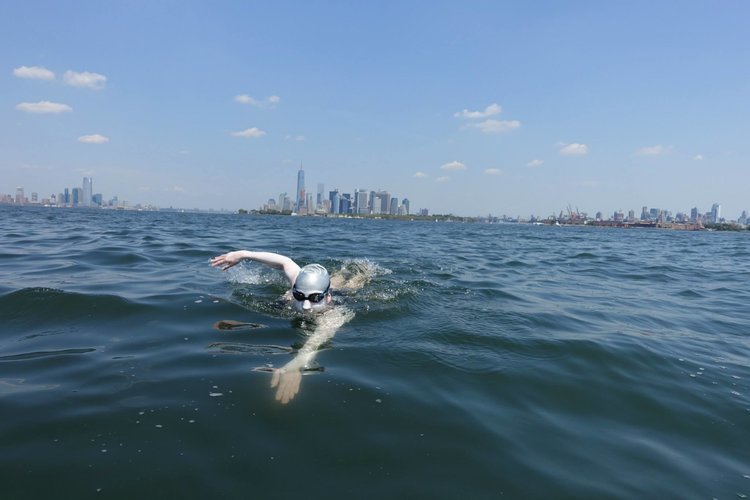
What’s it been like not being able to travel and swim?
It’s been really strange. In my “other life” I do cold water swimming. There’s a circuit that we travel all around the world and it gives a cadence to my life. Especially in the early months of quarantine, the only thing I was doing besides working at my desk was maybe a walk by the river or a trip to the grocery store. It made me appreciate how good life normally is. Of course, in the grand scheme of things we were fortunate not to fall ill or unemployed. But compared to my normal routine of travelling and seeing wonderful places, this was very different.
You appear to have made the most of a bad situation. Talk me through that insane challenge of swimming around Manhattan seven times in seven days and how it came about.
This was kind of an audacious project. We learned that we would be able to swim again at the end of July. I have a personal project called The Mannahatta Project. Currently here in New York, a very big inspiration of mine is this delightful and impressive woman called Julie Ridge and she was the original “Queen of Manhattan Island” with twelve swims of Manhattan. She was also the first person in the world to do a double Manhattan circumnavigation. Kris Rutford from Nebraska is an accomplished athlete who has been doing a Manhattan swim every year since basically the late eighties, which is so wild, and over the years he has actually done 23 different swims. These are people I look up to for their love of New York City and this swim. This is a swim that I could do every day because the landscape is always different.
We have this amazing group of pilots and observers as part of the local swim community. With most of the local organisations cancelling their season, I reached out to our team and said: “Hey, I’ve got this crazy idea, I just want to do as many loops as possible this year.” Fortunately, they were really excited about it and were completely supportive. I did three swims prior to the big week, then on the Monday we started what we hoped would be a week of seven back to back swims.
How special is it for you to be able to see New York from a perspective that few people will ever have the opportunity to experience?
Honestly, that’s what I love about it and what I love about so many of the swims that I do around the world. We get to see something that no one has ever seen before. Through the Harlem River, it doesn’t even look like NYC; it could be some place in the American South. It looks like a small, very industrial town – it’s so interesting. Throughout the swim, you can see a lot of the things that have changed over the years, like little fishing shacks that people have put up in upper Manhattan that they add to, they put lights on, they decorate with balloons. Looking at some of the photos, you wouldn’t even think it’s NYC or Manhattan at all. There’s also a point where you’re transitioning from Harlem to the Hudson and all the downtown skyline is framed through the George Washington Bridge, which is huge, and the last bridge that you will see. I always hear the old Jay Z song Empire State of Mind when I see the skyline framed with the bridge. I just get a lift in my heartbeat. It never ceases to thrill me every single time. It’s so funny.
You have broken so many records in your marathon and ice swimming career. Does breaking records motivate you, or are you driven by your love for open water swimming and travelling?
I feel passionate about the experience itself as opposed to records. I get excited about things that haven’t been done before or things that are unusual or inspiring to me. I’ve been lucky that a couple of times the things that I have decided to do have been records, but I don’t think I could stay motivated if I was just working away at someone else’s list of records or swims. Even when I did the Ice Sevens challenge, it was a first, but for me, it wasn’t a prescribed list. It was basically like: hey, an ice mile is a mile swim below 5 degrees on every continent, you can do it wherever, whenever you want, you can take five years or a month to do it if possible. I was in control of the project and the whole world was my canvas. For me, that was a really cool thing.
How do you fit swimming into your personal and professional life?
I have a demanding corporate job as the US Campus Recruiting Manager for Scotiabank, an international investment bank. After university, I worked for ten years on Wall Street to build my career before starting open water swimming. Since then I’ve balanced my ice and marathon swimming career with my work in banking and management consulting. These industries are equally demanding in terms of hours and endurance, which can affect training. But one thing that I always say is that if I have times when I’m working hard, only sleeping a few hours a night, or have to pull an all-nighter for work, it’s a different kind of training because the experience comes in handy for marathon swims which are more than 24 hours.
You have recently featured in the book Strong Like Her. What does it mean to you to and how important is the history of marathon swimming in your open water pursuits?
It’s been a huge honour for me to be included with many of my historic heroines, and Haley, the writer, is just amazing. I didn’t tell her that story of The PS General Slocum, but that was something that she had researched on her own and it resonated with me as it was something that I was always motivated by. It’s actually funny, my partner of 20 years, Arik Thormahlen, has a very uncommon last name, and it’s because a lot of his family were wiped out in that disaster. It was a big coincidence that NYC history, marathon swimming history and his family history all overlapped there. It was amazing to me that Haley had done that research and legwork to make that jump and that it aligned with my personal story as well. But yes, I’m so inspired by marathon swimmers historically – especially female swimmers. Many swims that I have done have been either inspired by or following in the footsteps of great women like Rose Pitonof or Diane Struble who was the first person to swim Lake George, or even Julie Ridge who was the first double Manhattan swimmer.
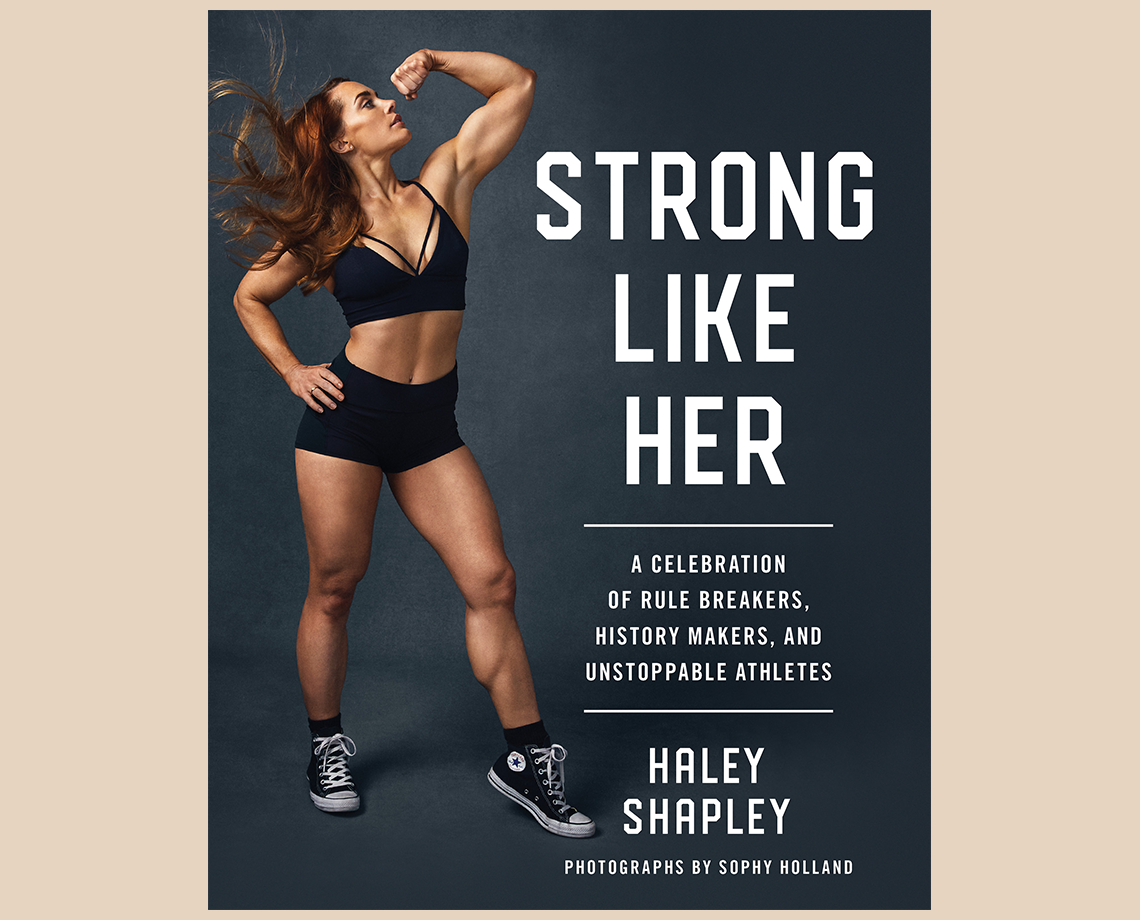
Strong Like Her: A Celebration of Rule
Breakers, History Makers and Unstoppable Athletes by Haley Shapley is out now,
published by Simon & Schuster.
How do you perceive yourself and your achievements in terms of the history of swimming?
It’s so flattering to even be included. I think the biggest compliment to me is when people tell me things like “I told my daughter about you” or if I’m approached by parents with kids and they ask about what we did, or when I was invited to give a TEDx talk to college students in Japan about my swimming. For me, the biggest upside of it is when anyone can seek inspiration from something that I’ve done, or for young girls to be like, wow this lady did it, then I can do it.
Are you secretly, or subconsciously maybe, in competition with other marathon and ice swimmers? What’s the dynamic among the best in the sport?
Oh my goodness, absolutely not. This keeps coming back to Taylor Swift, I don’t know why, but it’s always weird that sometimes people imagine these rivalries with female pop stars, or female athletes for example. Achievement in open water swimming is not a zero-sum game; we are all energised and inspired when great things are happening in the sport. It’s of particular importance for me to support other female athletes. And personally, I look up to contemporaries like Chloë McCardel, Anna-Carin Nordin, and Alisa Fatum, Julia Wittig, and Barbara Hernandez Huerta. Cameron Bellamy has been an inspiration too. We also have this new crop of amazing female 20-something marathon swimmers like Cat Breed and even an American 16-year-old who just swam the English Channel. It’s a small community, we all know each other and share tips and help each other out where possible.
*It’s at this point that my first phone call with Monahan comes to an end. She suggests flying to London next year to take part in the Thames Marathon, then leaves for a busy day of conference calls and a “big kick-off meeting for work”.
The following weekend I hear the news that she has just completed one of the biggest and never-before-attempted swims in the history of marathon swimming: a 4-way circumnavigation of Manhattan Island. I catch up with Jaimie a few days after her historic 114 mile/ 184 km swim, which took 45 hours, 24 minutes.*
Huge congratulations. What an incredible achievement. When did you know that you would attempt the swim?
Over the last couple of years, the weekend of the United Nations (UN) General Assembly has been one of the strongest tide days. Usually we can’t swim that weekend because they block the entire East River for security reasons. But this year, once they announced the Assembly would be virtual, I saw it as a bonus day that we should do something with. I’d wanted to do a Quadruple for years, so we started planning earlier in the summer and finalised plans after the week of seven swims.
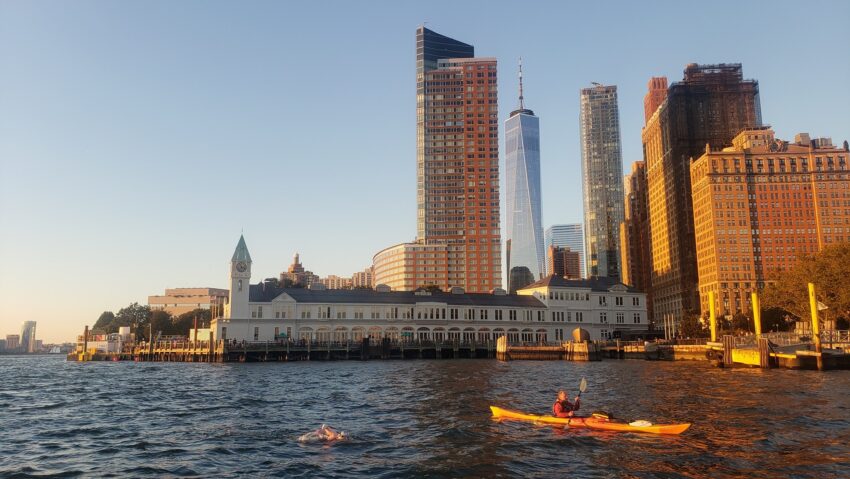
Monahan makes her way past the One World Trade Center during her record-breaking Quadruple Manhattan Swim
How did the swim go?
This was my longest swim both in terms of distance and hours in the water. I had done a double before, but it was current assisted, so I got a lot more support from the tides. Timewise, I had done Lake Geneva, which was 42 miles and took me almost 33 hours to swim. I’m lucky that I’m good with sleep deprivation. It’s something that I encounter a lot with my busy season with work. My strategy for it was not to take any caffeinated drinks in my first lap, then to increase taking them gradually during the remaining laps.
My first lap was totally normal, but it was a shame that I had to pull back and not take advantage of the current and tread water to meet the tides for my second lap. The second was at night and I was expecting the wind to die down, but it just didn’t. It’s always hardest for me before the sun comes up, so as I went into the third lap, I was tempted just to do a double. But I told myself I had to keep swimming until daylight. By the time it came up, I was feeling good and had some energy and warmth back. By the time I finished, maybe in the last hour, my throat was swelling a bit from the saltwater – that was probably the toughest part.
Did you hear the Jay-Z song as you went under the final bridge?
Yes, I had the song in my head – of course! The mental jukebox was really fun; it was really on point. It was playing some oldies, lots of Taylor Swift and some good tunes, so that was fun.
Is your Mannahatta Project now complete?
I’m a New Yorker; this is a life-long project. I think eventually I’d love – if I live long enough and stay healthy – to do some loops as long as I’m alive and have the ability to do so. A lot of people swim into their 80s. With the project itself, short-term, it was a big milestone for me to do the Quadruple. With the first lap of the Quad I was able to surpass the record for the most completions of the route and become the Queen of Manhattan, so setting this new mark of 27 circumnavigations was a labour of love and a big achievement.
How do you feel now reflecting on what you have achieved?
It’s all been really amazing. With everyone struggling with the pandemic, racial justice, and everything else going on, it’s just been a tough year. For people to see something meaningful and inspiring, I think it has resonated with people and I’m so thankful for all the messages and support that folks have showed me.





